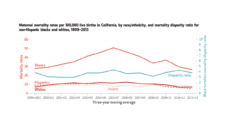Racial inequities in maternal and infant health are well-documented. Compared to whites, Black, Hispanic and Asian/Pacific Islander people face higher rates of severe maternal morbidity. And Black people are more than three times as likely to die from pregnancy-related causes than their white counterparts. These inequities are thought to be the result of a complex web of interpersonal, systemic, and structural racism. One manifestation of structural racism that has received little attention is access to paid family leave to care for a new baby.
Paid family leave allows new parents to take time away from work to recover from childbirth and bond with a new child without losing their paycheck. And it has been linked to health and economic benefits for families, by decreasing rates of low birthweight and poverty, increasing breastfeeding and household income, and improving maternal mental health.
The U.S. is the only high-income country in the world without paid leave for new parents. A growing number of states have paid family leave policies, but most workers still must rely on their employers to provide these benefits voluntarily. No surprise, inequity is high.
While 40% of the highest wage workers have paid family leave through their jobs, just 7% of the lowest wage workers do. Little research, however, has examined racial and ethnic inequities in access to paid leave. We conducted the Bay Area Parental Leave Study of Mothers, a survey of women giving birth in the San Francisco Bay Area in 2016-2017, to understand how expanding paid leave policies improves access and related health outcomes.
Black and Hispanic women are less likely than white women to say they received paid leave through their employers or California’s Paid Family Leave program.
We found that Black and Hispanic women are less likely than white women to say they received paid leave through their employers or California’s Paid Family Leave program. To summarize the magnitude of the problem, we estimated the number of “full-pay equivalent” weeks of leave by multiplying the amount of pay received throughout leave with the number of weeks of leave taken. Asian women received 0.9 fewer weeks of full-pay equivalent leave than white women, Hispanic women received 2 fewer weeks, and Black women received 3.6 fewer weeks. Despite this substantial pay difference, new parents took about the same amount of leave across racial and ethnic groups. This suggests that, at least in the Bay Area, the lack of paid leave potentially widens the wealth gap between white women and women of color in this critical period around childbirth.
What causes these inequities in access to paid leave, especially in a state like California with a statewide program? One issue is that the policies don’t cover everyone. Many state paid family leave policies have minimum hours and/or job tenure requirements, or exclude public sector workers.
Another issue is that paid leave policies don’t necessarily protect jobs, so workers who take leave under these laws still risk unemployment. The Family and Medical Leave Act, a national law that provides up to 12 weeks of job-protected, unpaid leave, has strict eligibility requirements resulting in only about half of all workers being covered.
Using our survey data, we estimated that just 40% of Hispanic women and 51% of Black women had job protection under FMLA rules, compared to 63% of white women. However, simulating job protection under a newer California law that expanded job protection to smaller employers, Black and Hispanic workers made significant gains (73% and 71%, respectively, compared to 78% of white workers).
Finally, many workers eligible for paid leave don’t know these benefits exist. We asked Bay Area mothers whether they’d heard of San Francisco’s Paid Parental Leave Ordinance, the first fully-paid leave policy in the country. Less than 10% of lower-income women had heard of the law and just 1.4% knew it provided 6 weeks of paid leave for both mothers and fathers.
We also found that only half of Black and Hispanic respondents said they understood their employers’ maternity benefits (compared to 74% of white respondents). Not surprising when only a quarter of Black and Hispanic respondents said that their employers helped them understand these benefits (compared to 59% of white respondents).
The potential for paid family leave policies to help narrow health inequities is high, particularly in maternal and infant health. Yet the complexity of these laws means that many people are excluded, don’t understand their rights well enough to use them, or don’t even know these policies exist. Universal paid leave policies – like those in most other high-income countries – may be needed if we want to realize equitable public health benefits.
Photo via Getty Images















